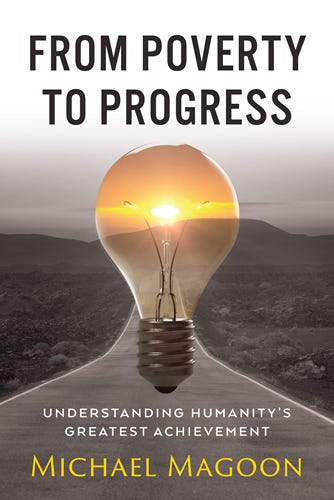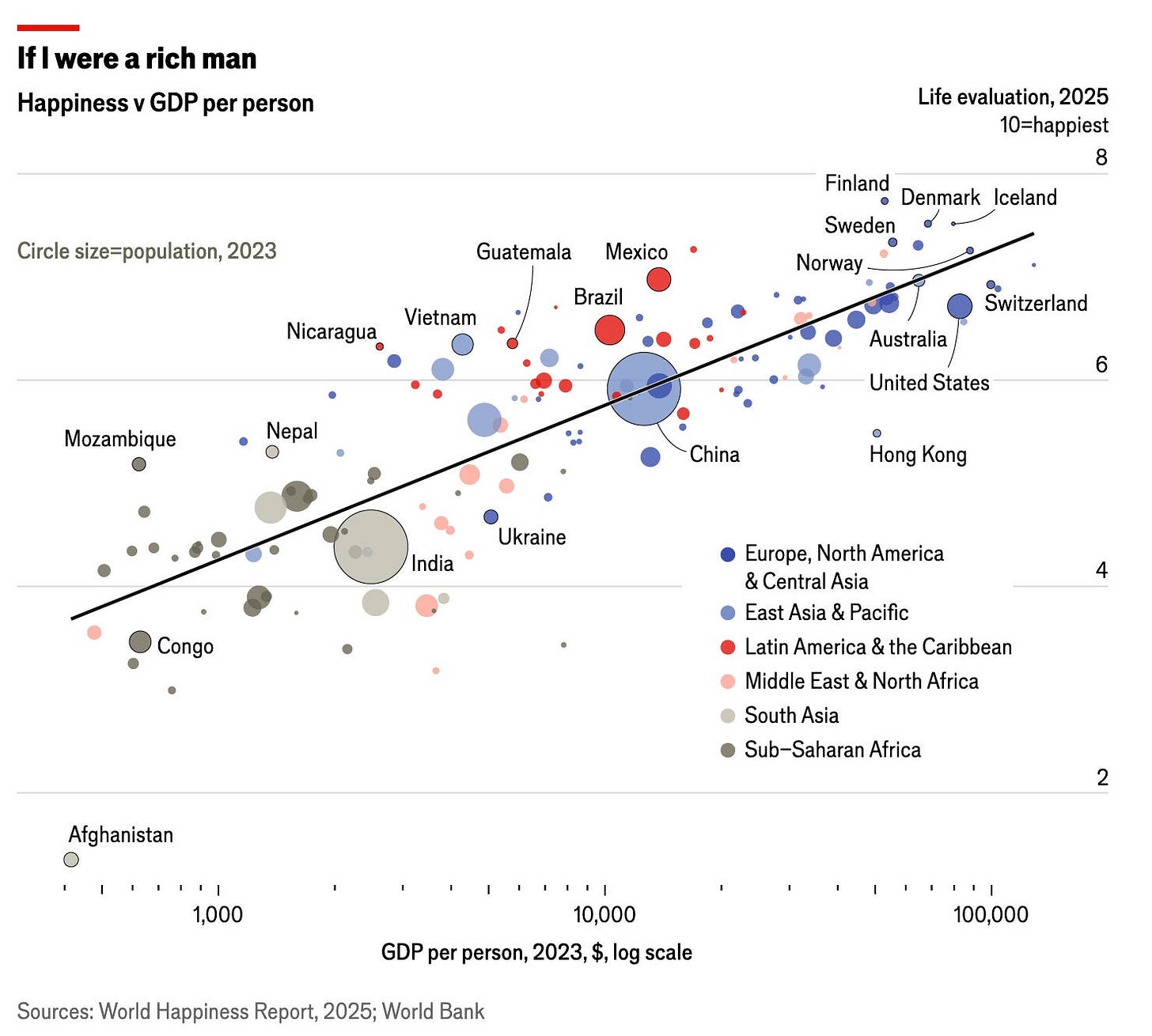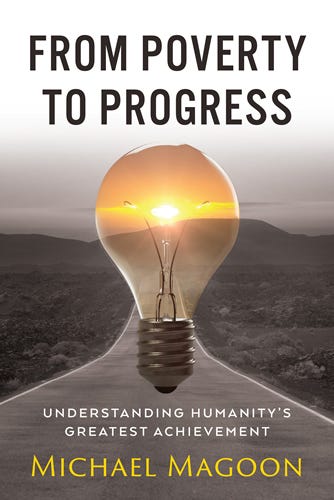Does material progress lead to happiness?
Some claim that material progress does not matter because it does not result in actual happiness. But is this the case?
Make someone’s day: Gift a subscription to your friends and family!
Human material progress is a fact. It can be seen in metrics of economic growth, human development, freedom, slavery, poverty, agricultural production, literacy, diet, famines, sanitation, drinking water, life expectancy, neonatal mortality, disease, education, access to electricity, housing, violence (to name just a few), and in virtually every nation. You can find many more in my first book.
Happiness
The question remains, however; does all this material improvement affect people’s happiness? Does better diet, health, education, sanitation, and standard of living, and lower levels of violence lead to greater happiness?
The World Value Survey enables us to measure levels of happiness in a concrete way. The poll started in 1981 and currently covers just under 100 countries. The following charts are based upon responses to the following question: “Taking all things together, would you say you are Very happy, Rather happy, Not very happy or Not at all happy”. The figures display the total percentage of respondents who reported themselves to be “Very happy” or “Rather happy”.
Some people, including me, are somewhat skeptical about how accurately these answers track with “real” happiness. While self-reported happiness is not a perfect measurement, it is closely correlated with other factors, such as frequency of smiling, rating of one’s happiness by friends, and activity in the parts of the brain associated with pleasure. Whatever its limitations, self-reported happiness is measuring something real.
The following is an excerpt from my book From Poverty to Progress: Understanding Humanity’s Greatest Achievement. You can purchase discounted copies of my book at my website, or pay full prize at Amazon.
See more articles on Evidence for Progress:
Book review: "Ten Global Trends Every Smart Person Should Know" by Bailey & Tupy
Long-term trends in per capita GDP (article; podcast; video)
Growth in per capita GDP (2012-2022) (article; podcast; video)
United Nations Human Development Index (article; podcast; video)
Does material progress lead to happiness? (article; podcast; video)
more.
Since there are over 200 nations today, it is not realistic to examine development metrics for every one of them in this book. And averages can cover up variations between rich and poor nations. We need a way to narrow the sample to a manageable number, but not in a way that creates a distorted impression of overall trends. In order to ensure that the data covers a very broad segment of the world’s population, I decided to focus on four distinct categories of nations.
The first group, which I will call the “Wealthy 12”, consists of 12 Western nations that industrialized early and currently have very high standards of living. Those nations are the United States, United Kingdom, Australia, Belgium, Canada, France, Germany, Netherlands, New Zealand, Norway, Sweden, and Switzerland. The Wealthy 12 gives us a good overview of the trends within the wealthiest nations.
Among the Wealthy 12, 90% or more people in every nation but Germany, answered that they were either Very Happy or Rather Happy. With the exception of Germany, which has a clear upward trend and the United States and Australia, which have somewhat of a downward trend, there is relatively little variation over time. So while not all respondents agree, the high standard of living of the Wealthy 12 has translated into widespread happiness.
The slight downward trend since the 2008 recession is disturbing, though. The magnitude is small (a decline on average from 92% to 91%), but it is clearly in the wrong direction. It is possible that wealthy nations have hit “Peak Happiness”, or it could be just a temporary dip due to economic recession. Either way, this short-term trend is trivial in comparison to the very high rates of self-reported happiness within the Wealthy 12.
The second group that I will show data for is what I call the “Populous 12”. This group consists of 12 of the most populous nations that did not have high per capita GDP in 2020. This group consists of China, India, Brazil, Congo, Egypt, Ethiopia, Indonesia, Iran, Mexico, Nigeria, Pakistan, and Turkey. Together these nations make up 58% of the world’s population and cover every continent except Australia and Antarctica. The Populous 12 gives us a broad overview of trends for people who live outside the wealthiest nations.
In 1994, when the first data come from, the nations within the Populous 12 had levels of happiness significantly below the Wealthy 12. They ranged from a high of 81% in Turkey to a low of 65% in Nigeria. From 1994 to 2020 average levels of self-reported happiness increased from 73% to 84%. Only Egypt and Iran experienced a downturn. Bear in mind that both of these nations experienced significant amounts of political turmoil during that period.
With the obvious exception of Egypt, levels of self-reported happiness in all these nations increased to above 80%. Progress in the Populous 12 has translated into increased self-reported happiness. Even Egypt has experienced an upturn since 2014 that has almost completely erased the previous downturn.
The third group is what I call the “Bottom 20”. This group consists of the 20 nations with the lowest scores on the United Nations Human Development Index in 1990 (the earliest year available). The nations in this group consist of Afghanistan, Benin, Burma, Burundi, Central African Republic, Congo, Gambia, Guinea, Malawi, Mali, Mauritania, Mozambique, Niger, Papua New Guinea, Rwanda, Senegal, Sierra Leone, Sudan, Tanzania and Uganda. The Bottom 20 gives us a good overview in trends of the most desperately poor nations in the world. If there is any group of nations that should lack evidence of progress, it is these 20 nations.
Unfortunately, the World Values Survey does not collect data on many of the countries within the Bottom 20 (so I am not including the graphic). Only Rwanda has multiple data points. Rwanda does show an increase in self-reported happiness, from 86% in 2009 to 90% in 2014. With so little data, however, it is impossible to draw any conclusions on how happiness levels changed in these countries.
The last group of nations is what I call the “Transformative 16”. This group consists of nations that experienced at least one generation of very strong economic growth after 1950 (or 20+ years of per capita GDP growth of over 3 percent). This level of economic growth would lead to a doubling of the standard of living of their people within one generation.
The Transformative 16 includes representatives from many different regions and cultures: Spain, Ireland, Japan, Hong Kong, Taiwan, Thailand, Singapore, South Korea, Indonesia, China, India, Israel, Botswana, Trinidad, Puerto Rico and Chile. The Transformative 16 gives us a good overview of the nations that experienced the fastest economic growth. It tests whether very rapid economic growth translates into positive changes throughout society.
The Transformative 16 saw a strong increase in self-reported happiness from 1994 to 2020. In 1993, the happiest nation was Japan at 78% and the least happy was China at 67%. By 2020, all nations but India had happiness levels of 80% or better. Only Puerto Rico failed to show an upward trend. Recent drops in happiness in Hong Kong and Thailand are likely related to political instability.
It is important to note that some of the happiest nations – Singapore and Spain – do not show an upward trend, but polling years are well after these nation’s periods of rapid growth, so these results do not invalidate the hypothesis that strong economic gains lead to increased happiness. All other nations in the Transformative 16 with more than a decade of polling data show increased happiness.
While we are missing data from the poorest nations, it is clear that all of the positive trends documented previously do, in fact, result in increased self-reported happiness. All of the Wealthy 12 nations have very high levels of self-reported happiness and virtually all of the Populous 12 and Transformative 12 show substantial increases in self-reported happiness. Many of those nations are getting close to the levels of happiness in the Wealthy 12. While political instability and economic recessions clearly have short-term effects on self-reported happiness, the long-term trends are positive.
The field of happiness research is rapidly growing and somewhat beyond the scope of this book, but I would like to summarize some key findings from the literature plus some graphics from Our World in Data:
People from richer nations report being happier than people from poorer nations.
Within nations, people with higher incomes report being happier than people with lower incomes. This holds for all 84 nations where we have data (with Mali being a possible exception).
As the average income of a nation grows, so does the average level of happiness of its people.
Economic growth leads to declining levels of happiness inequality, even if income inequality is also increasing. In other words, economic growth benefits the unhappy more than the happy. This is probably due to public goods that benefit everyone regardless of their income: better water, sanitation, education, health care, lower violence, etc.
People tend to underestimate the level of happiness of other people within their society.
Much of the above is an excerpt from my book From Poverty to Progress: Understanding Humanity’s Greatest Achievement. You can purchase discounted copies of my book at my website, or pay full prize at Amazon.
See more articles on Evidence for Progress:
Book review: "Ten Global Trends Every Smart Person Should Know" by Bailey & Tupy
Long-term trends in per capita GDP (article; podcast; video)
Growth in per capita GDP (2012-2022) (article; podcast; video)
United Nations Human Development Index (article; podcast; video)
Does material progress lead to happiness? (article; podcast; video)
more.
















As Dostoevsky wrote in "Notes from Underground, "If all man had to do was sleep, eat cake and create the next generation, he would perform some evil trick and tear it all down. " Material satiation is not the answer to happiness. Humans need challenges. They need something to push against and to accomplish.
As an older man I have a sense that life has many phases. One major phase, which takes place in one's 20s and 30s, is that of narcissism and that "everything is about me." If you were lucky and had good parents, they told you how special you were and you believed them.
Humans, and particularly young men, often transition out of this narcissistic phase when they meet a wonderful woman and get married. Suddenly, they have responsibilities beyond their own, personal petty wants. They now have some responsibilities for another human being.
Having children is the next major step in civilizing men. They now learn the real meaning of "sacrifice" and commitment to others. Often later in life both men and women must provide support and help for aging parents, which is another life lesson in the move away from narcissism.
Some folks eventually learn that the real road to happiness is one lined with sacrifice, commitment and dedication. Best put: Service to Others. If one lives their life in such a way that even one other person breathed a bit easier because they existed , then and only then may they even consider that they lived a moral, honorable, worthwhile life. A successful life.
Just an old soul livin' in a new world.
PS: I just turned 77 in May 2024. I currently am in good health both physically and cognitively. I go to the gym every day. I write essays, short stories and commentaries. I essentially live my life in the service of 1) My Wife 2) Our Grown Children 3) Our Grandchild 4) My elderly sister 5) My dear friends 6) My neighbors 7) My community 8) My nation. Me? Where do I rank myself? Somewhere in the top 20.
So…
Money can't buy happiness. But it contributes to it.
But I also believe that happiness is a matter of comparison.
Imagine that no one has a car (or cars haven't been invented yet). One can not be unhappy to have to walk in the rain. That's just how it is. But imagine that the overall economic situation improve and now 25% of the people can get a car. Those who cannot get one are now quite unhappy about the situation.
And that apply to most of the material wealth and even to much tragic situations like child mortality.
So were medieval peasants happy ? Undoubtfully, they were very poor compare to nowadays standard of living. They had small hovels, ate the same food almost everyday and probably saw half of their children dying well before reaching the age of one. But if the harvest was good, their lord left them enough to eat and no invaders burned down their village for sometime, maybe they would say they were quite happy. Maybe even happier than most farmers today.
So happiness would not come so much from material wealth but from the fair distribution (or whatever considered as fair in a given culture) of the available wealth.